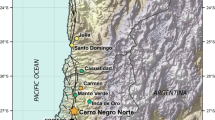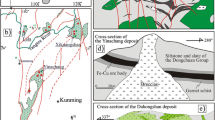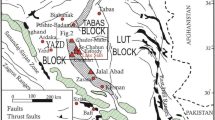Abstract
The phoscorite-carbonatite complex at Sokli, northeastern Finland, is composed of five stages of intrusions of phoscorites and carbonatites (P1-C1, P2-C2, P3-C3 phoscorites and calcite carbonatites, D4 and D5 dolomite carbonatites) which are cut by numerous lamprophyric dikes. Magnetite is ubiquitous in all constituent rock units of the complex and frequently associates with ilmenite. Most ilmenite intergrowths from the Sokli phoscorite-carbonatite complex occur as internal and/or external granules (composite type exsolutions) or sandwich type exsolution lamellae in the host magnetites. Discrete ilmenite crystals are found only in P3 and C3. On the other hand, ilmenites in the ultramafic lamprophyres occur as discrete crystals as well as trellis and sandwich type exsolution lamellae or composite type exsolutions in magnetite. Electron microprobe analyses reveal that magnetite of the Sokli complex belongs essentially to the magnetite-ulvöspinel solid solution series with a small proportion of magnesioferrite. The compositions of magnetite from the Sokli phoscorite-carbonatite complex vary systematically from stage to stage with increasing Fe2+/(Fe2++Mg) ratio, and decreasing Al, Mn and Ti contents. Magnetite from the ultramafic lamprophyre is characterized by large compositional ranges owing to the large amount of mantle-derived xenocrysts. Some grains are particularly high in Cr (up to 21.0 wt.% Cr2O3). Aluminous magnesian titanomagnetites are also found, but most magnetites in the ultramafic lamprophyres are pure magnetite. The compositional variation of ilmenite from the Sokli complex is mainly caused by the substitution of Fe2+ into Mg and Mn, and partly Ti into Nb. Mg-and Mn-rich ilmenites in the early stage P1-C1 rocks evolve towards pure FeTiO3 composition in the latest D5 dolomite carbonatite. Ilmenites from the ultramafic lamprophyres are relatively poor in Mn compared to those from the phoscorite-carbonatite complex. In the coexisting magnetite and ilmenite, Mg and Mn cations preferentially partition into ilmenite rather than magnetite. In spite of the mineralogical and geochemical contrasts between the phoscorites and associated carbonatites, compositions of Fe−Ti oxide minerals from the two paired rocks at a given stage are basically the same, and evolve systematically from stage to stage. This supports the hypothesis that the phoscorites and conjugate carbonatites are derived from common parental melts. Furthermore, the intrusions of the Sokli phoscorite-carbonatite complex are considered to have either crystallized from successive batches representing a continuum in time and magmatic evolution, or that the P1-C1 parental magma has simply differentiated to form the later stage rocks.
Similar content being viewed by others
References
Bell, K., Dunworth, E.A., Bulakh, A.G. and Ivanikov, V.V., 1996, Alkaline rocks of the Turiy, Peninsula, Russia, including typelocality turjaite and turjite: a review. The Canadian Mineralogist, 34, 265–280.
Bergstøl, S., 1972, The jacupirangite at Kodal, Vestfold, Norway: A potential magnetite, ilmenite and apatite ore. Mineral Deposita, 7, 233–246.
Chakhmouradian, A.R. and Zaitsev, A.N., 1998, Calcite-amphiboleclinopyroxene rock from the Africanda complex, Kola Peninsula, Russia: mineralogy and a possible link to carbonatites. I. Oxide minerals. The Canadian Mineralogist, 37, 177–198.
Czamanske, G.E. and Mihalik, P., 1972, Oxidation during magmatic differentiation, Finnmarka complex, Oslo area, Norway: Part I. The opaque oxides. Journal of Petrology, 13, 493–509.
Droop, G.T.R., 1987, A general equation for estimating Fe3 concentrations in ferromagnesian silicates and oxides from microprobe analyses, using stoichiometric criteria. Mineralogical Magazine, 51, 431–435.
Garanin, V.K., Kudriavtseva, G.P. and Lapin, A.V., 1980, Typical features of ilmenite from kimberlites, alkali-ultrabasic intrusions, and carbonatites. International Geological Reviews, 22, 1025–1050.
Gaspar, J.C. and Wyllie, P.J., 1983a, Magnetite in the carbonatites from the Jacupiranga complex, Brazil. American Mineralogist, 68, 195–213.
Gaspar, J.C. and Wyllie, P.J., 1983b, Ilmenite (high Mg, Mn, Nb) in the carbonatites from the Jacupiranga complex, Brazil. American Mineralogist, 68, 960–971.
Ghiorso, M.S. and Sack, R.O., 1991, Thermochemistry of the oxide minerals. In: Lindsley, D.H. (ed.), Oxide minerals: petrologic and magnetic significance. Reviews in Mineralogy, 25, Mineralogical Society of America, Washington, D.C., p. 221–264.
Haggerty, S.E., 1975, The chemistry and genesis of opaque minerals in kimberlite. Physics and Chemistry of the Earth, 9, 295–307.
Haggerty, S.E., 1976a, Oxidation of opaque mineral oxides in basalts. In: Rumble, A. (ed.), Oxide minerals, Reviews in Mineralogy, III, Mineralogical Society of America, Washington, D.C., p. 1–100.
Haggerty, S.E., 1976b, Opaque mineral oxides in terrestrial igneous rocks. In: Rumble, A. (ed.), Oxide minerals Reviews in Mineralogy, III, Mineralogical Society of America, Washington, D.C., p. 101–300.
Haggerty, S.E., 1991a, Oxide mineralogy of the upper mantle. In: Lindsley, D.H. (ed.), Oxide minerals: petrologic and magnetic significance. Reviews in Mineralogy, 25, Mineralogical Society of America, Washington, D.C., p. 355–315.
Haggerty, S.E., 1991b, Oxide textures: A mini-atlas. In: Lindsley, D.H. (ed.), Oxide minerals: petrologic and magnetic significance. Reviews in Mineralogy, 25, Mineralogical Society of America, Washington, D.C., p. 129–219.
Haggerty, S.E., 1994, Upper mantle mineralogy. Journal of Geodynamics, 20, 331–346.
Kogarko, L.N., Kononova, V.A., Orlova, M.P. and Woolley, A.R., eds., 1995, Alkaline rocks and carbonatites of the World: Part 2. Former USSR. Chapman and Hall, London, 225 p.
Kramm, U., Kogarko, L.N., Kononova, V.A. and Vartiainen, H., 1993, The Kola Alkaline Province of the CIS and Finland: Precise Rb−Sr ages define 380–360 Ma age range for all magmatism. Lithos, 30, 33–44.
Krasnova, N.I., Balaganskaya, E.G. and Garcia, D., 2004, Kovdorclassic phsocorites and carbonatites. In: Wall, F. and Zaitsev, A.N. (eds.), Phoscorites and carbonatites from mantle to mine: the key example of the Kola Alkaline Province. Mineralogical Society Series 10, The Mineralogical Society of Britain & Island, London, p. 99–132.
Krasnova, N.I. and Krezer, Yu.L., 1995, New data on the nature of fine and ultrafine lamellac in titanomagnetite. European Journal of Mineralogy, 7, 1361–1372.
Kukharenko, A.A., Orlova, M.P., Bulakh, A.G., Bagdasarov, E.A., Rimskaya-Korsakova, O.M., Nefedov, E.I., Ilinskiy, G.A., Sergeev, A.S. and Abakumova, N.B., eds., 1965, the Caledonian ultramafic alkaline rocks and carbonatites of the Kola Peninsula and Northern Karelia. Nedra Press, Moscow, 772 p. (in Russian).
Lee, M.J., Garcia, D., Moutte, J. and Lee, J.I., 2003a, Phlogopite and tetraferriphlogopite from phoscorite and carbonatite associations in the Sokli massif, Northern, Finland. Geosciences Journal, 7, 9–20.
Lee, M.J., Lee, J.I., Moutte, J. and Kim, Y., 2003b, Petrography and geochemistry of the Devonian ultramafic lamprophyre at Sokli in the northeastern Baltic Shield (Finland). Journal of the Petrological Society of Korea, 12, 170–183.
Lee, M.J., Garcia, D., Moutte, J., Williams, C.T. and Wall, F., 2004, Carbonatites and phoscorites from the Sokli complex, Finland. In: Wall, F. and Zaitsev, A.N. (eds.), Phoscorites and carbonatites from mantle to mine: the key example of the Kola Alkaline Province. The Mineralogical Society of Britain & Ireland, London, p. 133–162.
Mitchell, R.H., 1973, Magnesian ilmenite and its role in kimberlites petrogenesis. Journal of Geology, 81, 301–311.
Mitchell, R.H., 1977, Geochemistry of magnesian ilmenite from kimberlites in Southern Africa and Lesotho. Lithos, 63, 544–547.
Mitchell, R.H., 1978, Manganoan magnesian ilmenite and titanian elinohumite from the Jacupiranga carbonatite, Sâopaulo, Brazil. American Mineralogist, 63, 544–547.
Mitchell, R.H. and Chakhmouradian, A.R., 1998, Instability of perovskite in a CO2-rich environment: examples from carbonatite and kimberlite. The Canadian Mineralogist, 36, 939–951.
Prins, P., 1972, Composition of magnetite from carbonatites. Lithos, 5, 227–240.
Rock, N.M.S., 1991, The nature and origin of the lamprophyres: alnöites and allied rocks. Journal of Petrology, 27, 155–196.
Sack, R.O., 1982, Spinels as petrogenetic indicators: Activity-composition relations at low pressures. Contribution to Mineralogy and Petrology, 79, 169–186.
Secher, K. and Larsen, L.M., 1980, Geology and mineralogy of the Sarfartôq carbonatite complex, southern West Greenland. Lithos, 13, 199–212.
Stéphane, B., 2001, Etude pétrologique et géochimique des deux petits massifs ultrabasique, alcalins et carbonatitiques de Vuorijarvi et de Sebljav (Péninsule de Kola, Russie). Master thesis, Université Libre de Bruxelles, Bruxelles, 113 p. (in French)
Vartiainen, H., 1980, The petrography, mineralogy and petrochemistry of the Sokli carbonatite massif northern Finland. Geological Survey of Finland, Bulletin, 313, 126 p.
Vartiainen, H., Kresten, P. and Kafkas, Y., 1978, Alkaline lamprophyres from the Sokli Complex, northern Finland Bulletin of the Geological Society of Finland, 50, 59–68.
Wolley, A.R., 1989, The spatial and temporal distribution of carbonatites. In: Bell, K. (ed.), Carbonatites, Genesis and Evolution. Unwin Hyman, London, p. 15–37.
Author information
Authors and Affiliations
Corresponding author
Rights and permissions
About this article
Cite this article
Lee, M.J., Lee, J.I. & Moutte, J. Compositional variation of Fe−Ti oxides from the Sokli complex, northeastern Finland. Geosci J 9, 1–13 (2005). https://doi.org/10.1007/BF02910549
Received:
Accepted:
Issue Date:
DOI: https://doi.org/10.1007/BF02910549




